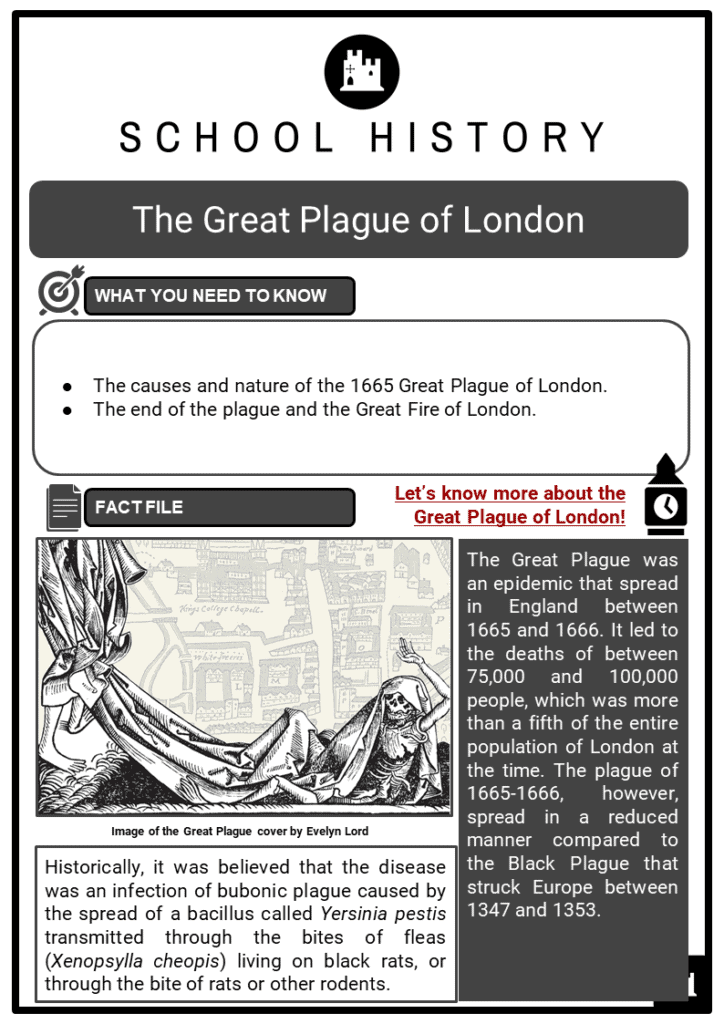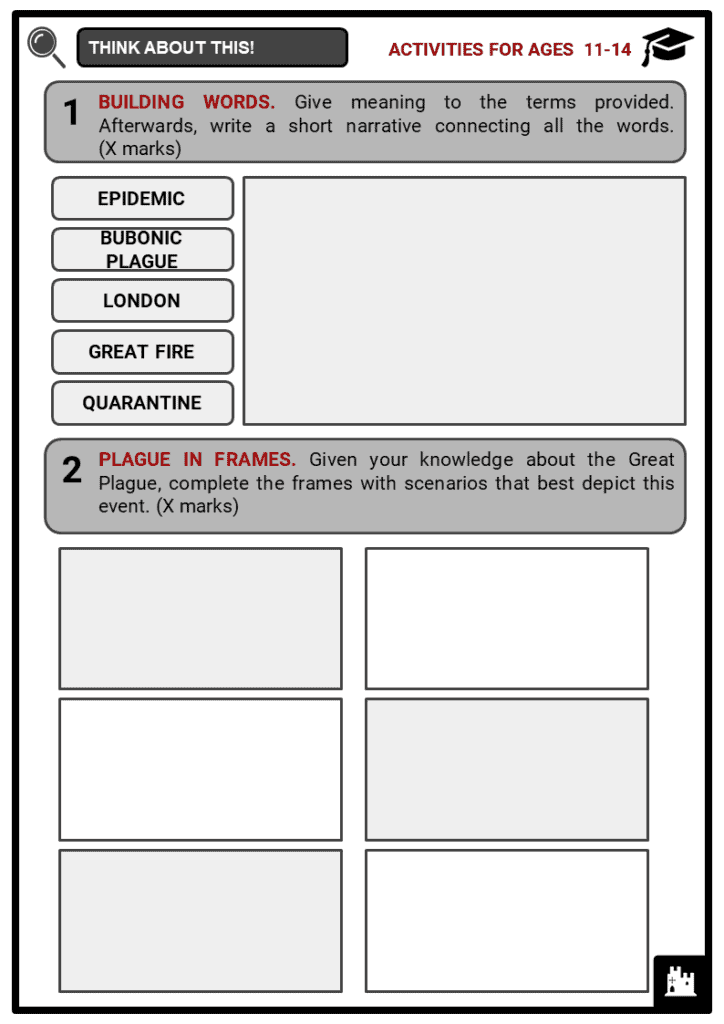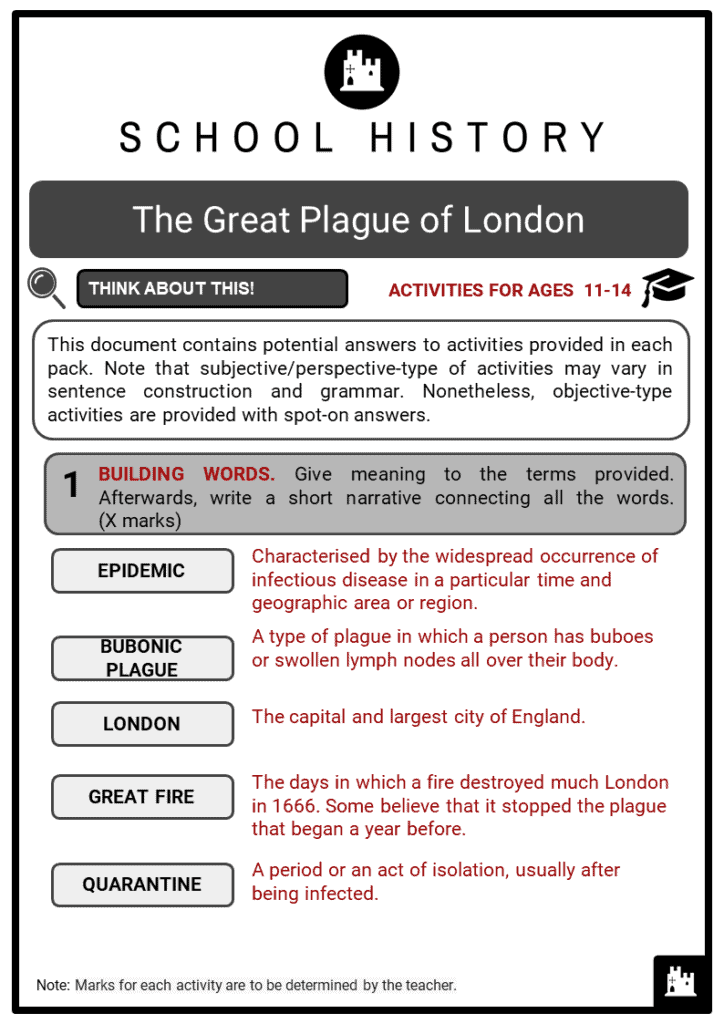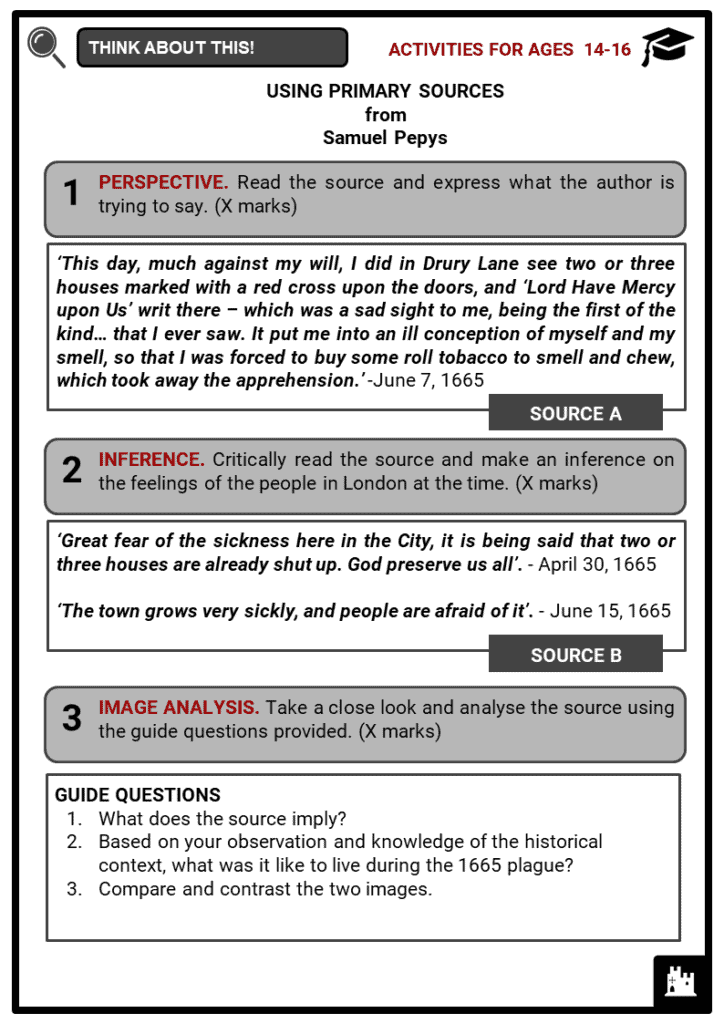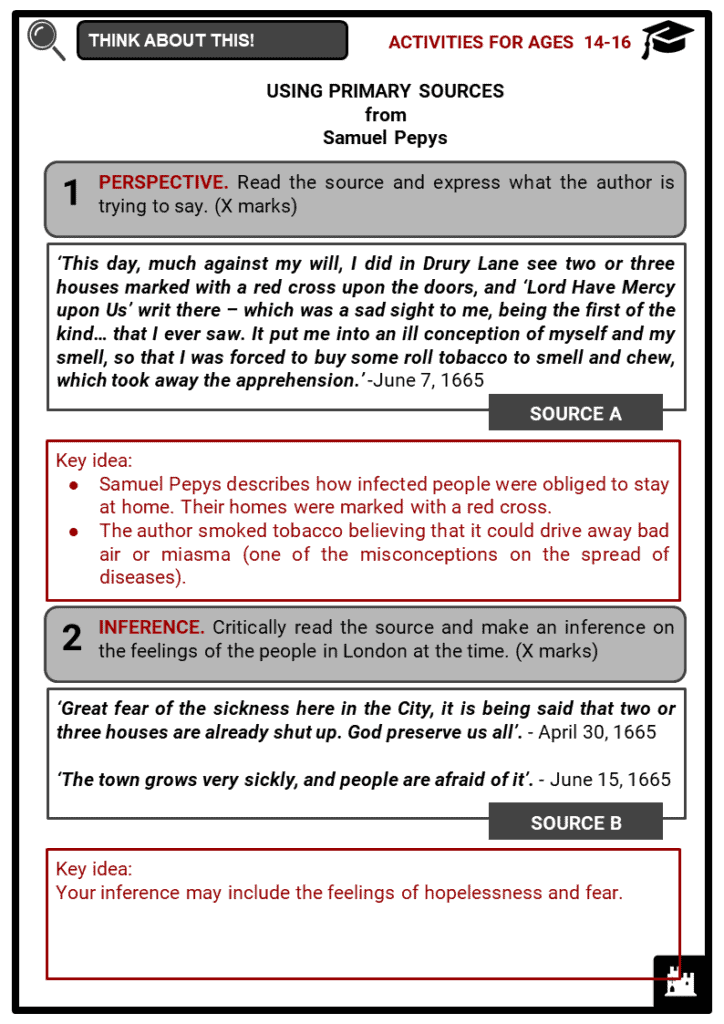Download The Great Plague of London Worksheets
Do you want to save dozens of hours in time? Get your evenings and weekends back? Be able to teach The Great Plague of London to your students?
Our worksheet bundle includes a fact file and printable worksheets and student activities. Perfect for both the classroom and homeschooling!
Table of Contents
Add a header to begin generating the table of contents
Summary
- The causes and nature of the 1665 Great Plague of London.
- The end of the plague and the Great Fire of London.
Key Facts And Information
Let’s know more about the Great Plague of London!
- The Great Plague was an epidemic that spread in England between 1665 and 1666. It led to the deaths of between 75,000 and 100,000 people, which was more than a fifth of the entire population of London at the time. The plague of 1665-1666, however, spread in a reduced manner compared to the Black Plague that struck Europe between 1347 and 1353.
- Historically, it was believed that the disease was an infection of bubonic plague caused by the spread of a bacillus called Yersinia pestis transmitted through the bites of fleas (Xenopsylla cheopis) living on black rats, or through the bite of rats or other rodents.
Causes and nature of the Great Plague of London
- The plague appeared very early in the country – in the summer of 1348 – and never really disappeared from the British Isles. However, at that time, people thought they could survive by avoiding it, and so, many fled the city and spread the plague more. The plague was then labelled as the Black Death, which in itself created panic and fear.
- It is thought that the plague was carried to England by Dutch ships trading cotton from Amsterdam. Since 1654, various areas of the Netherlands had been affected by a similar disease.
- Areas outside of London were the first to be affected by the spread of the plague. During the winter of 1664-1665, many contracted the disease and died. However, the winter was cold enough to contain the plague.
- The year 1665 was marked by a scorching summer. As the population in London continued to grow, many lived in poverty and squalid conditions. Indeed, the only way for people to get rid of their waste was to throw it out of their windows onto the street. The city of London was, therefore, very dirty and an ideal habitat for rats.
- Naturally, the first victims of the plague were the people living in the most precarious and miserable conditions. These people lived in slums and could not avoid contact with rats nor avoid contact with infected people.
- During the resurgence of the plague, it was believed that cats and dogs were responsible for transmitting the disease.
- The Mayor of London, therefore, decided to eliminate all of them, which meant fewer predators of rats. Daniel Defoe – in his book Journal Of The Plague Year – states that about 40,000 dogs and 200,000 cats died needlessly since the plague did not come from them.
Symptoms & Spread
- The nursery rhyme below refers to the plague of London and is symbolic of the disease’s symptoms: Ring-a-ring of roses, A pocketful of posies. Attischo, Attischo, We all fall down
- The first line references the red spots that developed on the skin of victims. It could also be a reference to the pus-filled buboes under the armpits or groin.
- The second line refers to another belief that the plague was spread through miasma – that bad smells were the cause of disease. It was thought that if one carried scented flowers or herbs in one’s pocket, one would be protected from miasma.
- The last symptom of the plague was a sneezing attack that usually led to death. However, most of the victims did not even reach that stage and died well before. The plague was almost always fatal.
- When the plague began to spread, healthy people who could afford to began rapidly abandoning the city. In June, the roads were filled with sick individuals and the Mayor responded by closing the gates. People were forbidden from leaving the city unless they had a certificate of good health.
- These certificates became highly sought after and many fake ones started to circulate.
- The poor were the most affected by the plague and London authorities decided to take drastic measures to prevent the disease from spreading further. All families whose members were affected by the disease were quarantined in their homes with a ban on going out.
- The house was chained from the outside and a red cross was painted on the door in order to warn others. The only people who were allowed in were nurses and doctors.
- In reality, the ‘nurses’ had no medical training and were local women who were paid to visit the infected houses. Thus, they went to see how the victims felt and brought food to those who could afford it.
- Some people condemned this practice since a few of these nurses took advantage of their status in order to steal goods from the houses they visited.
- In July 1665, when the plague was spreading quickly in London. King Charles II and the royal family decided to move to Oxford (an area which had remained untouched by the infection). By contrast, the Mayor of London and the council remained in the city.
- Many commercial enterprises came to an end due to the low volumes of merchandise and the disappearance of merchants. Only a small number of clergy, doctors, and pharmacists stayed in London with the intention of helping overcome the plague.
- These individuals included the Archbishop of Canterbury and the Bishop of London.
- Those who remained tried to stop the infection from spreading. They used flaming torches night and day, believing it would keep the air clean, and spices such as pepper and resins were used as incense to combat miasma. In addition, the authorities urged citizens to consume tobacco.
- London was not the only city in England to be struck by the plague. The most famous is the case of Eyam village in the Derbyshire region, where the plague was carried by a trader who transported fabric bought in London: despite efforts to contain the infection, over 70% of the population died.
- Contemporary analysis suggests that over one thousand people died per week. Such estimates then increased to two thousand, and, in September 1665, reached seven thousand victims per week. At the end of autumn, the contagion began to subside and the king and the court were able to return to the city.
The end of the plague and the Great Fire of London
- Episodes of plague continued for several months until the outbreak of the Great Fire, which devastated much of the city of London.
- On September 2, 1666, a fire started in the King’s Bakery in Pudding Lane near London Bridge. Due to the very hot summer and strong easterly wind, the fire quickly spread in wooden houses and buildings.
- About 300 houses collapsed rapidly. People began to panic as flames spread. Many left the city via the River Thames.
- Despite the king’s orders to create a fire-break, the fire outpaced it. After two days, half of London was in flames. Bigger fires were created as gunpowder stored in houses blew up. Due to a number of explosions, even more panic was created as rumours of a French invasion began to spread.
- On September 6th, the fire was brought under control. The Tower of London luckily survived, while only one-fifth of London was left. About 13,000 houses were destroyed along with most civic buildings. Amazingly, only six people died.
- The fire left about 100,000 Londoners homeless. Amidst the additional disaster, people believed that the fire ended the Great Plague as it killed and drove out rats that caused the disease.
- London officially declared about 68,596 deaths caused by the Great Plague. Most of the casualties were from bubonic plague.
- People were paid to bury the bodies that the London authorities found. The unfortunate victims were loaded on a cart and thrown into mass graves. Other people were in charge of removing dogs and cats (which were considered responsible for the disease).
- Some scholars suggest that the Great Fire had nothing to do with the end of the plague, as deaths in London began to diminish even before the September 2nd incident.
Image sources:
[2. ] https://upload.wikimedia.org/wikipedia/commons/d/dd/Plague_in_London%2C_1665_Wellcome_M0010582.jpg

